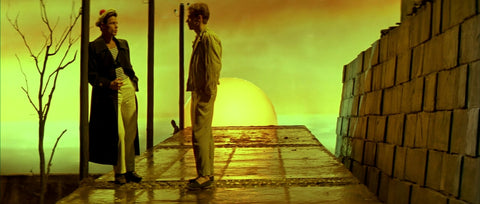On Justin Liam O'Brien's print, Each Man Kills the Thing He Loves
Posted on
By Helen Edwards
“I'm interested in the idea that as beautiful as love is, it can also be extreme, painful, even deadly.” – Justin Liam O’Brien
New York-based artist Justin Liam O’Brien’s work examines feelings of solitude, intimacy, anxiety and violence through an art historical lens with sweeping, figurative compositions. We are excited to offer a deeper look inside his practice to learn more about his influences for his most recent print collaboration with ART FOR CHANGE, Each Man Kills the Thing He Loves.
|
Justin Liam O’Brien signing Each Man Kills the Thing He Loves |
As a student at Pratt, O’Brien studied 3D animation, focusing on video game and graphic design and using software programs like Sketch-Up to construct characters and animations. Extra time during the pandemic allowed him to re-evaluate his career, and step away from his computer to take the plunge to painting full time. Smooth shading, stark shadow and a smooth, luminous, figurative style exemplify the formal training that has come to define his style and influences from some of his contemporaries including fellow ART FOR CHANGE artist, Danielle Orchard.
FILM: QUERELLE (1983)

|
| “I’m on the brink of shame from which no man ever rises. But only in that shame will I find my everlasting peace. I’m so weak, I’ve been conquered. Totally conquered.” Querelle |
Querelle, the posthumously-released final film from prolific German filmmaker, Rainer Werner Fassbinder, follows the titular sailor, Querelle, during his sojourn onshore and the entanglements around the Hotel Feria Bar. Completed just before his sudden death and based on the Jean Genet novel, Querelle of Brest, Fassbinder charges the novelist’s police thriller to transcendent moral heights with lust, deceit, murder, and self-discovery. In Each Man Kills the Thing He Loves, O’Brien peels back symbolic and physical layers of one of the film’s defining, explosive conflicts. Based upon the climactic, choreographed knife fight between the brothers Querelle and Robert, a sizzling, yellow, orange and green color palette on a pristine set with gel spotlights casting shadows along the cast’s faces, silhouetting the dramatic set in a mirage of heated gradients.
READING: BALLAD OF READING GAOL (1897)
A frequent refrain throughout the film–most notably in the film’s jaunty, original song performed by Jeanne Moureau–Fassbinder returns to O’Brien’s titular line, Each Man Kills the Thing He Loves from Oscar Wilde’s epic, Ballad of Reading Gaol, as a sort of chorus of psychological deaths of coming to terms with queer desire and the lengths it is taken to throughout the film. Wilde composed Ballad of Reading Gaol from his jail cell while he was serving two years of hard labor for his 1895 conviction for “acts of gross indecency with other male persons.’”
Ballad of Reading Gaol is both a stunning aesthetic achievement of the popular folk ballad style and a biting work of social commentary on capital punishment, guilt, and passion. Following the private execution of a shamed husband being taken to his death for the murder of his wife, Wilde’s poem details how life in captivity, pain, loss, and suffering inherent to the human condition, may be a worse punishment than death itself.
QUEER NEW YORK: DAVID WOJNAROWICZ, PETER HUJAR, and ACT UP

|
|
David Wojnarowicz (1954–1992), I Feel A Vague Nausea, 1990 Five gelatin silver prints, acrylic, string, and screenprint on composition board, 62 × 50 × 3in. (157.5 × 127 × 7.6 cm). Collection of Michael Hoeh. Image courtesy the Estate of David Wojnarowicz and P.P.O.W, New York Source: The Whitney Museum of Art |
“My work deals with the experience of being othered, feeling apart. I came to make work about this largely because of artists from the ACT UP generation like David Wojnarowicz, Nan Goldin, and Peter Hujar.” – Justin Liam O’Brien
Visual artist and activist David Wojnarowicz and photographer Peter Hujar were partners at the forefront of the downtown art scene during the 1980’s. Witnessing the epidemic ravage New York City, killing tens of thousands of queer men for four years before President Ronald Reagan would ever publicly address the disease, Wojnarowicz would rally against the establishment’s ignorance and disregard for communities affected by AIDS through his death in 1992. Wojnarowicz’s later works compound the beauty of life embodied with the fragility and wrath of nature and inequities, death, and disappearance.

|
| Peter Hujar: Chloe Finch, 1981, gelatin silver print; at the Fundación MAPFRE. © The Peter Hujar Archive, LLC. Source: The Morgan Library & Museum |
Hujar’s photographs capture a remarkable intimacy and warmth unified across subject matters. A skilled technician defined by use of stark shadows in black and white photographs, Hujar chronicled life downtown with a presence and vitality that put him in a league of his own. After his death in 1987, Wojnarowicz would move into his East Village loft and bring new life to the negatives stored in the space. In both of their works, as in Querelle, the discarded and displaced take center stage—a humanistic unification and honor of society’s outcasts.

|
| Justin Liam O'Brien Holding Each Man Kills the Thing He Loves |
Justin Liam O’Brien’s work taps into this queer art historical legacy and testifies to the timeless themes and questions that have concerned queer artists for decades. In reimagining these references in his contemporary, techno-figurative style, O’Brien’s work epitomizes a burgeoning generation of queer artists working in New York City.